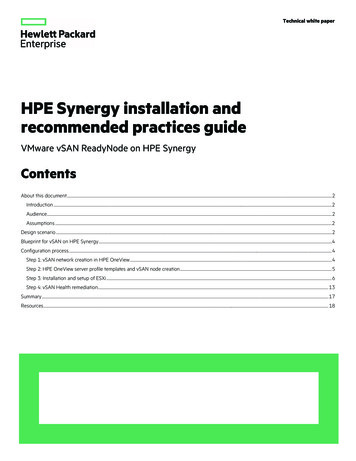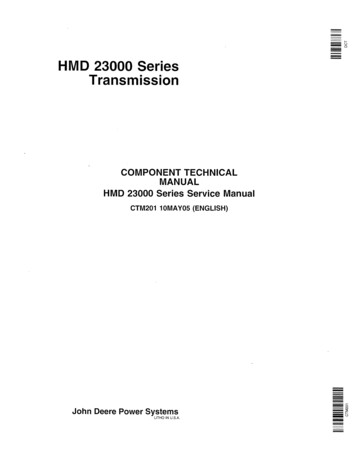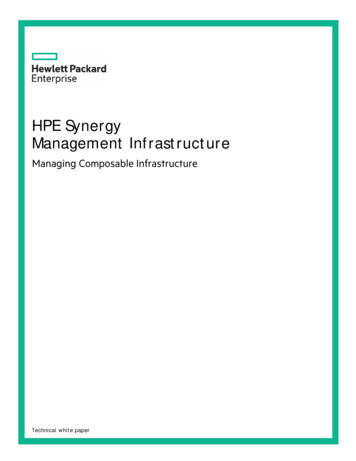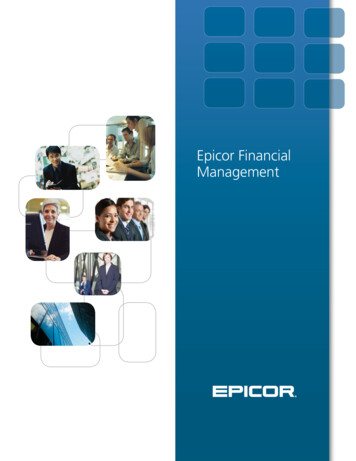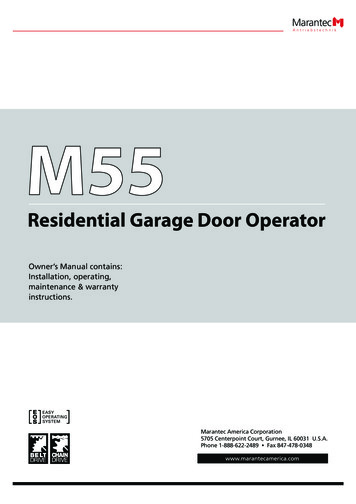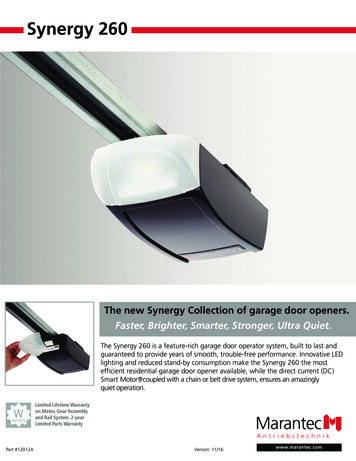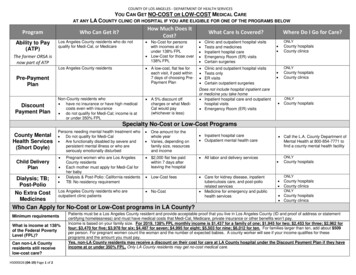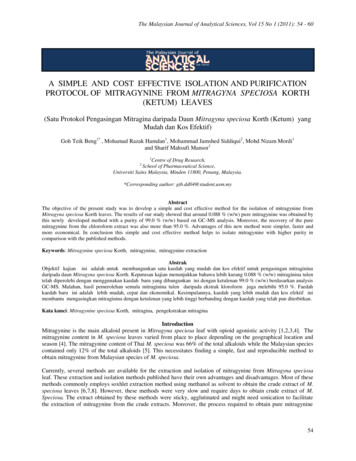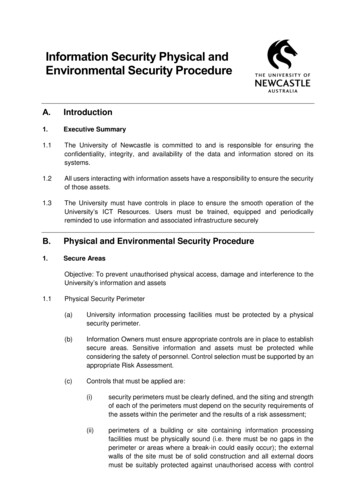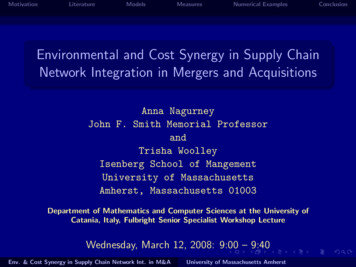
Transcription
MotivationLiteratureModelsMeasuresNumerical ExamplesConclusionEnvironmental and Cost Synergy in Supply ChainNetwork Integration in Mergers and AcquisitionsAnna NagurneyJohn F. Smith Memorial ProfessorandTrisha WoolleyIsenberg School of MangementUniversity of MassachusettsAmherst, Massachusetts 01003Department of Mathematics and Computer Sciences at the University ofCatania, Italy, Fulbright Senior Specialist Workshop LectureWednesday, March 12, 2008: 9:00 – 9:40Env. & Cost Synergy in Supply Chain Network Int. in M&AUniversity of Massachusetts Amherst
odels4Measures5Numerical Examples6ConclusionEnv. & Cost Synergy in Supply Chain Network Int. in M&AMeasuresNumerical ExamplesUniversity of Massachusetts AmherstConclusion
odels4Measures5Numerical Examples6ConclusionEnv. & Cost Synergy in Supply Chain Network Int. in M&AMeasuresNumerical ExamplesUniversity of Massachusetts AmherstConclusion
MotivationLiteratureModelsMeasuresNumerical ExamplesConclusionFirms and the EnvironmentPollution has major adverse consequences including globalwarming, acid rain, rising oceanic temperatures, smog, andthe resulting harmful effects on wildlife and human health.Firms, in turn, are increasingly realizing the importance oftheir environmental impacts and the return on the bottom linefor those actions expended to reduce pollution (Hart andAhuja (1996)).For example: 3M saved almost 500 million by implementing over 3000projects that have reduced emissions by over 1 billion poundssince 1975 (Walley and Whitehead (1994)). DuPont, has the equivalent of 35% of its share price investedin capital and operating expenditures related to protecting theenvironment. A 15% improvement in efficiency, for instance,could yield nearly 3 per share (Walley and Whitehead (1994)).Env. & Cost Synergy in Supply Chain Network Int. in M&AUniversity of Massachusetts Amherst
MotivationLiteratureModelsMeasuresNumerical ExamplesConclusionFirms and the EnvironmentFirms in the public eye have not only met, but exceeded, therequired environmental mandate (Lyon (2003)).In the U.S., over 1,200 firms voluntarily participated in theEPA’s 33/50 program, agreeing to reduce certain chemicalemissions 50% by 1995 (Arora and Cason (1996)).Customers and suppliers will punish polluters in themarketplace that violate environmental rules. Polluters mayface lower profits, also called a “reputational penalty,” whichwill be manifested in a lower stock price for the company(Klein and Leffler (1981), Klassen and McLaughlin (1996)).Roper Starch Worldwide (1997) noted that more than 75% ofthe public will switch to a brand associated with theenvironment when price and quality are equal.Nearly 60% percent of the public favors organizations thatsupport the environment (Roper Starch Worldwide (1997)).Env. & Cost Synergy in Supply Chain Network Int. in M&AUniversity of Massachusetts Amherst
MotivationLiteratureModelsMeasuresNumerical ExamplesConclusionMerger ActivityIn the first 9 months of 2007, according to Thomson Financial,worldwide merger activity hit 3.6 trillion, surpassing the totalfrom all of 2006 combined (Wong (2007)).Successful mergers can add tremendous value; however, thefailure rate is estimated to be between 74% and 83% (Devero(2004)).It is worthwhile to develop tools to better predict theassociated strategic gains, which include, among others, costsavings (Eccles, Lanes, and Wilson (1999)).A successful merger depends on the ability to measure theanticipated synergy of the proposed merger (cf. Chang(1988)).Env. & Cost Synergy in Supply Chain Network Int. in M&AUniversity of Massachusetts Amherst
MotivationLiteratureModelsMeasuresNumerical ExamplesConclusionDeveloping Countries and the EnvironmentWith the growing investment and industrialization indeveloping nations, it is also important to evaluate the overallimpact of merger activities at not only the operational level,but also as related to environmental impacts.There is enormous potential for developing countries to adoptcleaner production, given current technologies as well as thelevels of private capital investments.For example, between 1988-1995, multinational corporationsinvested nearly 422 billion worth of new factories, supplies,and equipment in these countries (World Resources Institute(1998)).Env. & Cost Synergy in Supply Chain Network Int. in M&AUniversity of Massachusetts Amherst
MotivationLiteratureModelsMeasuresNumerical ExamplesConclusionDeveloping Countries and the EnvironmentThrough globalization, firms of industrialized nations canacquire those firms in developing nations that offer lowerproduction costs; however, more than not, combined withinferior environmental concerns.As a result of the industrialization of developing countries, theactions taken today will greatly influence the future scale ofenvironmental and health problems.Env. & Cost Synergy in Supply Chain Network Int. in M&AUniversity of Massachusetts Amherst
odels4Measures5Numerical Examples6ConclusionEnv. & Cost Synergy in Supply Chain Network Int. in M&AMeasuresNumerical ExamplesUniversity of Massachusetts AmherstConclusion
MotivationLiteratureModelsMeasuresNumerical ExamplesConclusionLiteratureFarrell and Shapiro (1990) used a Cournot oligopoly model todemonstrate that when synergistic gains are possible throughpost-merger economies of scale, it is in consumer intereststhat price does not increase (also see Stennek (2003)).Spector (2003) shows that the failure to generate synergiesfrom any profitable Cournot merger must raise prices, even iflarge-scale entry or the avoidance of a fixed cost is possible.Farrel and Shapiro (2001) also study synergy effects related tocost savings related to economies of scale, competition, andconsumer welfare that could only be obtained post-merger.They specifically claim that direct competition has an impacton merger-specific synergies.Env. & Cost Synergy in Supply Chain Network Int. in M&AUniversity of Massachusetts Amherst
MotivationLiteratureModelsMeasuresNumerical ExamplesConclusionLiteratureSoylu et al. (2006) analyzed synergy among different energysystems using a multi-period, discrete-continuous mixedinteger linear program (see also Xu (2007)).Lambertini and Mantovani (2007) conclude that horizontalmergers can contribute to reduce negative externalities relatedto the environment.According to Stanwick and Stanwick (2002), if environmentalissues are ignored the value of the proposed merger can begreatly compromised.Env. & Cost Synergy in Supply Chain Network Int. in M&AUniversity of Massachusetts Amherst
MotivationLiteratureModelsMeasuresNumerical ExamplesConclusionTransportation LiteratureThere is virtually no literature to-date that discusses therelationship between post-merger operational synergy and theeffects on the environment and, thus, ultimately, society. Weattempt to address this issue from a quantitative perspective.We develop a multicriteria decision-making optimizationframework that not only minimizes costs but also minimizesemissions.Multicriteria decision-making has been recently much-exploredas related to the transportation network equilibrium problem.Env. & Cost Synergy in Supply Chain Network Int. in M&AUniversity of Massachusetts Amherst
MotivationLiteratureModelsMeasuresNumerical ExamplesConclusionTransportation LiteratureNagurney, Dong, and Mokhtarian (2002) include the weightingof travel time, travel cost, and the emissions generated.For general references on transportation networks andmulticriteria decision-making, see Nagurney and Dong (2002).Multicriteria decision-making within a supply chain hasassisted in the production and delivery of products by focusingon factors such as cost, quality, and lead times (Talluri andBaker (2002)).Dong, Zhang, and Nagurney (2002) proposed a supply chainnetwork that included multicriteria decision-makers at eachtier of the supply chain, including the manufacturing tier, theretailer tier, and the demand markets.Env. & Cost Synergy in Supply Chain Network Int. in M&AUniversity of Massachusetts Amherst
MotivationLiteratureModelsMeasuresNumerical ExamplesConclusionSystem View StructureSarkis (2003) has demonstrated that environmental supplychain management, also referred to as the green supply chain,is necessary to address environmental concerns.For example, the Ford Motor company demanded that all ofits 5000 worldwide suppliers with manufacturing plants obtaina third party certification of environmental managementsystem (EMS) by 2003 (Rao (2002)).Env. & Cost Synergy in Supply Chain Network Int. in M&AUniversity of Massachusetts Amherst
MotivationLiteratureModelsMeasuresNumerical ExamplesConclusionSystem View StructureWe provide a system-optimization perspective for supplychains, a term originally coined by Dafermos and Sparrow(1969) in the context of transportation networks andcorresponding to Wardrop’s second principle of travel behaviorwith user-optimization corresponding to the first principle(Wardrop (1952)).Nagurney (2006), subsequently, proved that supply chainnetwork equilibrium problems, in which there is competitionamong decision-makers within a tier, but cooperation betweentiers, can be reformulated and solved as transportationnetwork equilibrium problems.Env. & Cost Synergy in Supply Chain Network Int. in M&AUniversity of Massachusetts Amherst
MotivationLiteratureModelsMeasuresNumerical ExamplesConclusionContributionThis work is built on the recent work of Nagurney (2007) whodeveloped a system optimization perspective for supply chainnetwork integration in the case of horizontal mergers.Nagurney, A. (2007) A System-Optimization Perspective forSupply Chain Integration: The Horizontal Merger Case. Toappear in Transportation Research E.We also focus on the case of horizontal mergers (oracquisitions) and we extend the contributions in Nagurney(2007) to include multicriteria decision-making andenvironmental concerns.We analyze the synergy effects associated with a merger, interms of the operational synergy, that is, the reduction, if any,in the cost of production, storage, and distribution, as well asthe environmental benefits in terms of the reduction ofassociated emissions (if any).Env. & Cost Synergy in Supply Chain Network Int. in M&AUniversity of Massachusetts Amherst
odels4Measures5Numerical Examples6ConclusionEnv. & Cost Synergy in Supply Chain Network Int. in M&AMeasuresNumerical ExamplesUniversity of Massachusetts AmherstConclusion
MotivationLiteratureModelsMeasuresNumerical ExamplesConclusionSupply Chains of Firms A and B Prior to the Merger: Case0Firm AFirm BAkBk@M1AAD1,1AD1,2R1A@R@k ···kM AAnMH H H HHj? A?k ···kD AM1BnD ,1BD1,1?k ···kD AA D B1,2nD ,2HH H HHj? A?k ···kR ARBEnv. & Cost Synergy in Supply Chain Network Int. in M&AnR1@@R@k ···kM BBnMH H H j? B? HHk ···kD BnD ,1? Bk ···kD BnD ,2HH H j? B? HHk ···kR BUniversity of Massachusetts AmherstnR
MotivationLiteratureModelsMeasuresNumerical ExamplesConclusionThe Pre-merger Multicriteria Decision-makingOptimization Problem (Case 0)Let Gi [Ni , Li ] for i A, B denote the graph consisting of nodesand directed links representing the economic activities associatedwith each firm i. Also let G 0 [N 0 , L0 ] i A,B [Ni , Li ].Following Nagurney (2007) we assume that there is a total costassociated with each link of the network corresponding to eachfirm i; i A, B. We denote the links by a, b, etc., and the totalcost on a link a by ĉa .The demands for the product are assumed as given and areassociated with each firm and retailer pair. Let dR i denote thekdemand for the product at retailer Rki associated with firm i;i A, B; k 1, . . . , nRi .Env. & Cost Synergy in Supply Chain Network Int. in M&AUniversity of Massachusetts Amherst
MotivationLiteratureModelsMeasuresNumerical ExamplesConclusionThe Pre-merger Multicriteria Decision-makingOptimization Problem (Case 0)A path is defined as a sequence of links joining an origin nodei A, B with a destination node Rki . Let xp denote thenonnegative flow of the product on path p.A path consists of a sequence of economic activities comprisingmanufacturing, storage, and distribution. The followingconservation of flow equations must hold for each firm i:Xxp dR i , i A, B; k 1, . . . , nRi ,kp P 0 iRkwhere PR0 i denotes the set of paths connecting (origin) node i withk(destination) retail node Rki .Env. & Cost Synergy in Supply Chain Network Int. in M&AUniversity of Massachusetts Amherst
MotivationLiteratureModelsMeasuresNumerical ExamplesThe Pre-merger Multicriteria Decision-makingOptimization Problem (Case 0)Let fa denote the flow of the product on link a.We must also have the following conservation of flow equationssatisfied:Xfa xp δap , p P 0 ,p P 0where δap 1 if link a is contained in path p and δap 0,otherwise.Here P 0 denotes the set of all paths, that is,P 0 i A,B;k 1,.,ni PR0 i .RkEnv. & Cost Synergy in Supply Chain Network Int. in M&AUniversity of Massachusetts AmherstConclusion
MotivationLiteratureModelsMeasuresNumerical ExamplesThe Pre-merger Multicriteria Decision-makingOptimization Problem (Case 0)Clearly, since we are first considering the two firms prior to anymerger the paths associated with a given firm have no links incommon with paths of the other firm.The path flows must be nonnegative, that is,xp 0, p P 0 .We group the path flows into the vector x.Env. & Cost Synergy in Supply Chain Network Int. in M&AUniversity of Massachusetts AmherstConclusion
MotivationLiteratureModelsMeasuresNumerical ExamplesConclusionThe Pre-merger Multicriteria Decision-makingOptimization Problem (Case 0)The total cost on a link, be it a manufacturing/production link, ashipment/distribution link, or a storage link is assumed to be afunction of the flow of the product on the link; see, for example,Nagurney (2007) and the references therein.Hence, we have thatĉa ĉa (fa ), a L0 .We assume that the total cost on each link is convex, iscontinuously differentiable, and has a bounded second order partialderivative.Env. & Cost Synergy in Supply Chain Network Int. in M&AUniversity of Massachusetts Amherst
MotivationLiteratureModelsMeasuresNumerical ExamplesConclusionThe Pre-merger Multicriteria Decision-makingOptimization Problem (Case 0)We also assume that there are nonnegative capacities on the linkswith the capacity on link a denoted by ua , a L0 .In addition, we assume, as given, emission functions for eacheconomic link a L0 and denoted by ea , whereea ea (fa ), a L0 ,where ea denotes the total amount of emissions generated by link ain processing an amount fa of the product. We assume that theemission functions have the same properties as the total costfunctions.Env. & Cost Synergy in Supply Chain Network Int. in M&AUniversity of Massachusetts Amherst
MotivationLiteratureModelsMeasuresNumerical ExamplesConclusionThe Pre-merger Multicriteria Decision-makingOptimization Problem (Case 0)Since the firms, pre-merger, have no links in common, theirindividual cost minimization problems can be formulated jointly asfollows:XMinimizeĉa (fa )a L0subject to the constraints presented earlier andfa ua ,Env. & Cost Synergy in Supply Chain Network Int. in M&A a L0 .University of Massachusetts Amherst
MotivationLiteratureModelsMeasuresNumerical ExamplesConclusionThe Pre-merger Multicriteria Decision-makingOptimization Problem (Case 0)In addition, since we are considering multicriteria decision-makingwith environmental concerns, the minimization of emissionsgenerated can, in turn, be expressed as follows:Xea (fa )Minimizea L0subject to the constraints presented earlier andfa ua ,Env. & Cost Synergy in Supply Chain Network Int. in M&A a L0 .University of Massachusetts Amherst
MotivationLiteratureModelsMeasuresNumerical ExamplesConclusionThe Pre-merger Multicriteria Decision-makingOptimization Problem (Case 0)We now construct a weighted total cost function, which we referto as the generalized total cost (cf. Fishburn (1970), Chankongand Haimes (1983), Yu (1985), Keeney and Raiffa (1992),Nagurney and Dong (2002)), associated with the two criteria facedby each firm with the weight associated with total costminimization being set equal to 1.Specifically, for notational convenience and simplicity, we definenonnegative weights associated with the firms i A, B and linksa Li , as follows: αia 0 if link a / Li and αia αi , otherwise,where αi is decided upon by the decision-making authority of firmi.Env. & Cost Synergy in Supply Chain Network Int. in M&AUniversity of Massachusetts Amherst
MotivationLiteratureModelsMeasuresNumerical ExamplesThe Pre-merger Multicriteria Decision-makingOptimization Problem (Case 0)Consequently, the multicriteria decision-making problem,pre-merger, can be expressed as:X XMinimizeĉa (fa ) αia ea (fa )a L0 i A,Bsubject to the constraints presented earlier andfa ua ,Env. & Cost Synergy in Supply Chain Network Int. in M&A a L0 .University of Massachusetts AmherstConclusion
MotivationLiteratureModelsMeasuresNumerical ExamplesConclusionThe Pre-merger Multicriteria Decision-makingOptimization Problem (Case 0)Observe that this problem is, as is well-known in the transportationliterature (cf. Beckmann, McGuire, and Winsten (1956), Dafermosand Sparrow (1969)), a system-optimization problem but incapacitated form and with multicriteria decision-making; see alsoPatriksson (1994), Nagurney (2000, 2006b), and the referencestherein.Under the above imposed assumptions, the optimization problem isa convex optimization problem. If we further assume that thefeasible set underlying the problem represented by the constraintsis non-empty, then it follows from the standard theory of nonlinearprogramming (cf. Bazaraa, Sherali, and Shetty (1993)) that anoptimal solution exists.Env. & Cost Synergy in Supply Chain Network Int. in M&AUniversity of Massachusetts Amherst
MotivationLiteratureModelsMeasuresNumerical ExamplesConclusionThe Pre-merger Multicriteria Decision-makingOptimization Problem (Case 0)Let K0 denote the set whereK0 {f x 0, and the constraints hold}, where f is the vectorof link flows.Also, associate the Lagrange multiplier βa with constraintfa ua , a L0for link a and denote the associated optimal Lagrange multiplier byβa . This term may also be interpreted as the price or value of anadditional unit of capacity on link a.Env. & Cost Synergy in Supply Chain Network Int. in M&AUniversity of Massachusetts Amherst
MotivationLiteratureModelsMeasuresNumerical ExamplesTheoremThe vector of link flows f 0 K0 is an optimal solution to thepre-merger problem if and only if it satisfies the followingvariational inequality problem with the vector of nonnegativeLagrange multipliers β 0 :X X ĉa (f ) ea (fa )a αia βa ] [fa fa ][ f faa0a L i A,B X[ua fa ] [βa βa ] 0a L0 f K0 , βa 0, a L0Env. & Cost Synergy in Supply Chain Network Int. in M&AUniversity of Massachusetts AmherstConclusion
MotivationLiteratureModelsMeasuresNumerical ExamplesConclusionSupply Chain Network after Firms A and B Merge: Case 10kHH HHFirm A Firm BHH jH AkBkM1AAD1,1AD1,2R1A@@@@R@R@k ···kM AA M B k · · ·kM BBnnM1 MPHH PP HH P H P HHHPP A ) j? BqP HHj?k ···kD Bk ···kD A D BnD ,11,1nD ,1? Bk ···kD AA D Bk ···kD B1,2n,2nD ,2DHH PPP HH P H H PP P ) j? B? HH HH q Pj?Bk ···kR AAkkR B···REnv. & Cost Synergy in Supply Chain Network Int. in M&AnR1University of Massachusetts AmherstnR
MotivationLiteratureModelsMeasuresNumerical ExamplesConclusionThe Post-merger Multicriteria Decision-makingOptimization Problem (Case 1)We refer to the network underlying this merger as G 1 [N 1 , L1 ].We associate total cost functions and emission functions with thenew links.We assume, for simplicity, that the corresponding functions on thelinks emanating from the supersource node are equal to zero.Env. & Cost Synergy in Supply Chain Network Int. in M&AUniversity of Massachusetts Amherst
MotivationLiteratureModelsMeasuresNumerical ExamplesConclusionThe Post-merger Multicriteria Decision-makingOptimization Problem (Case 1)A path p now originates at the node 0 and is destined for one ofthe bottom retail nodes.Let xp now in the post-merger network configuration denote theflow of the product on path p joining (origin) node 0 with a(destination) retailer node.Then the following conservation of flow equations must hold:Xxp dR i , i A, B; k 1, . . . , nRi ,kp P 1 iRkwhere PR1 i denotes the set of paths connecting node 0 with retailnode Rki .kEnv. & Cost Synergy in Supply Chain Network Int. in M&AUniversity of Massachusetts Amherst
MotivationLiteratureModelsMeasuresNumerical ExamplesConclusionThe Post-merger Multicriteria Decision-makingOptimization Problem (Case 1)Due to the merger, the retail outlets can obtain the product fromany manufacturing plant and any distributor. The set of pathsP 1 i A,B;k 1,.,ni PR1 i .RkIn addition, as before, we let fa denote the flow of the product onlink a. Hence, we must also have the following conservation of flowequations satisfied:Xfa xp δap , p P 1 .p P 1Of course, we also have that the path flows must be nonnegative,that is,xp 0, p P 1 .Env. & Cost Synergy in Supply Chain Network Int. in M&AUniversity of Massachusetts Amherst
MotivationLiteratureModelsMeasuresNumerical ExamplesConclusionThe Post-merger Multicriteria Decision-makingOptimization Problem (Case 1)We assume, again, that the links representing the manufacturingactivities, the shipment, and the storage activities possessnonnegative capacities, denoted as ua , a L1 . This can beexpressed asfa ua , a L1 .We assume that, post-merger, the weight associated with theenvironmental emission cost minimization criterion is denoted by αand this weight is nonnegative.This is reasonable since, unlike in the pre-merger case, the firmsare now merged into a single decision-making economic entity andthere is now a single weight associated with the emissionsgenerated.Env. & Cost Synergy in Supply Chain Network Int. in M&AUniversity of Massachusetts Amherst
MotivationLiteratureModelsMeasuresNumerical ExamplesConclusionThe Post-merger Multicriteria Decision-makingOptimization Problem (Case 1)The post-merger optimization problem is concerned with total costminimization as well as the minimization of emissions.The following multicriteria decision-making optimization problemmust now be solved:XMinimize[ĉa (fa ) αea (fa )]a L1subject to the constraints described earlier.Note that L1 represents all links in the post-merger networkbelonging to firm A and to firm B.Env. & Cost Synergy in Supply Chain Network Int. in M&AUniversity of Massachusetts Amherst
MotivationLiteratureModelsMeasuresNumerical ExamplesConclusionThe Post-merger Multicriteria Decision-makingOptimization Problem (Case 1)There are distinct options for the weight α and we explore severalin the concrete numerical examples.Specifically, in the case that the merger/acquisition is anenvironmentally hostile one, then we may set α 0.In the case that it is environmentally conscious, then α may be setto 1; and so on, with α being a function of the firms’ pre-mergerweights also a possibility.Env. & Cost Synergy in Supply Chain Network Int. in M&AUniversity of Massachusetts Amherst
MotivationLiteratureModelsMeasuresNumerical ExamplesConclusionThe Post-merger Multicriteria Decision-makingOptimization Problem (Case 1)The solution to the post-merger multicriteria decision-makingoptimization problem subject to the described constraints can alsobe obtained as a solution to a variational inequality problem wherea L1 .α is substituted for αi , and the vectors: f , x, and β have identicaldefinitions as before, but are re-dimensioned/expanded accordingly.Finally, instead of the feasible set K0 we now haveK1 {f x 0, and the poster merger constraints hold}. Wedenote the solution to the variational inequality problem governingCase 1 by f 1 , β 1 .Env. & Cost Synergy in Supply Chain Network Int. in M&AUniversity of Massachusetts Amherst
MotivationLiteratureModelsMeasuresNumerical ExamplesConclusionTheoremThe vector of link flows f 1 K1 is an optimal solution to thepost-merger problem if and only if it satisfies the followingvariational inequality problem with the vector of nonnegativeLagrange multipliers β 1 :XX ĉa (f ) ea (fa )a[ α βa ] [fa fa ] [ua fa ] [βa βa ] 0, f faa11a La L f K1 , βa 0, a L1Env. & Cost Synergy in Supply Chain Network Int. in M&AUniversity of Massachusetts Amherst
odels4Measures5Numerical Examples6ConclusionEnv. & Cost Synergy in Supply Chain Network Int. in M&AMeasuresNumerical ExamplesUniversity of Massachusetts AmherstConclusion
MotivationLiteratureModelsMeasuresNumerical ExamplesConclusionQuantifying Synergy Associated with MulticriteriaDecision-Making Firms with Environmental Concerns inMergers/AcquisitionsWe define the total generalized cost TGC 0 associated with thepre-merger problem, or Case 0 as the value of the pre-mergerobjective function evaluated at its optimal solution f 0 .We define the total generalized cost TGC 1 associated withthe post-merger problem, or Case 1, as the value of thepost-merger objective function evaluated at its optimalsolution f 1 .These flow vectors we obtain from the solutions of thevariational inequalities for the pre and post merger cases,respectively.Env. & Cost Synergy in Supply Chain Network Int. in M&AUniversity of Massachusetts Amherst
MotivationLiteratureModelsMeasuresNumerical ExamplesConclusionQuantifying Synergy Associated with MulticriteriaDecision-Making Firms with Environmental Concerns inMergers/AcquisitionsThe synergy associated with the total generalized costs whichcaptures both the total costs and the weighted total emissions isdenoted by S TGC and is defined as follows:S TGC [TGC 0 TGC 1] 100%TGC 0Env. & Cost Synergy in Supply Chain Network Int. in M&AUniversity of Massachusetts Amherst
MotivationLiteratureModelsMeasuresNumerical ExamplesConclusionQuantifying Synergy Associated with MulticriteriaDecision-Making Firms with Environmental Concerns inMergers/AcquisitionsWe define TC 0 as the total costs generated under solutionf 0 .We define TC 1 as the total costs generated under solutionf 1 .Env. & Cost Synergy in Supply Chain Network Int. in M&AUniversity of Massachusetts Amherst
MotivationLiteratureModelsMeasuresNumerical ExamplesConclusionQuantifying Synergy Associated with MulticriteriaDecision-Making Firms with Environmental Concerns inMergers/AcquisitionsWe can also measure the synergy by analyzing the total costs preand post the merger (cf. Eccles, Lanes, and Wilson (1999) andNagurney (2007)), as well as the changes in emissions. Forexample, the synergy based on total costs and proposed byNagurney (2007), but not in a multicriteria decision-makingcontext, which we denote here by S TC , can be calculated as thepercentage difference between the total cost pre vs the total costpost merger:TC 0 TC 1] 100%S TC [TC 0Env. & Cost Synergy in Supply Chain Network Int. in M&AUniversity of Massachusetts Amherst
MotivationLiteratureModelsMeasuresNumerical ExamplesConclusionQuantifying Synergy Associated with MulticriteriaDecision-Making Firms with Environmental Concerns inMergers/AcquisitionsWe define TE 0 as the total emissions generated undersolution f 0 .We define TE 1 as the total emissions generated undersolution f 1 .Env. & Cost Synergy in Supply Chain Network Int. in M&AUniversity of Massachusetts Amherst
MotivationLiteratureModelsMeasuresNumerical ExamplesConclusionQuantifying Synergy Associated with MulticriteriaDecision-Making Firms with Environmental Concerns inMergers/AcquisitionsThe environmental impacts related to the relationship between preand post merger emission levels can also be calculated using asimilar measure as that of the total cost. Towards that end we alsodefine the total emissions synergy, denoted by S TE as:S TE [TE 0 TE 1] 100%TE 0Env. & Cost Synergy in Supply Chain Network Int. in M&AUniversity of Massachusetts Amherst
odels4Measures5Numerical Examples6ConclusionEnv. & Cost Synergy in Supply Chain Network Int. in M&AMeasuresNumerical ExamplesUniversity of Massachusetts AmherstConclusion
MotivationLiteratureModelsMeasuresNumerical ExamplesConclusionPre-Merger Supply Chain Network Topology for theNumerical ExamplesFirm AFirm BAkBk@M1A@R@kkM A2M1B@kM B2AD1,1k@@R@kD BAD1,2?k?kD B@@@R@@R@R1Ak@@R@k@R@1,11,2kR AEnv. & Cost Synergy in Supply Chain Network Int. in M&A2R1BkkR BUniversity of Massachusetts Amherst2
MotivationLiteratureModelsMeasuresNumerical ExamplesConclusionPost-Merger Supply Chain Network Topology for theNumerical Examplesk0 HHH HH Firm AFirm B jH kABk@@@R@R@kkM A M B kkM B21 2XXX @X @ XXXX @ @X@R @R9 zXAkkD BD@M1A1,1AD1,2R1Ak1,1?kkD B1,2XXX @XXX @ XXX@@R @R@zX9 kR AkR BRB kEnv. & Cost Synergy in Supply Chain Network Int. in M&A21University of Massachusetts Amherst2
MotivationLiteratureModelsMeasuresNumerical ExamplesDefinition of the Links and the Associated EmissionFunctions for the Numerical ExamplesLink a12345678910111213141516171819202122From M1AM2AM1BM2BAD1,2AD1,2BD1,2BD1,2To ,2R1BR2BBD1,1BD1,1AD1,1AD1,1R1BR2BR1AR2AEnv. & Cost Synergy in Supply Chain Network Int. in M&AEx. 1,4: ea (fa 22Ex. 2,3: ea (fa )5f15f25
network integration in the case of horizontal mergers. Nagurney, A. (2007) A System-Optimization Perspective for Supply Chain Integration: The Horizontal Merger Case. To appear in Transportation Research E. We also focus on the case of horizontal mergers (or acquisiti
